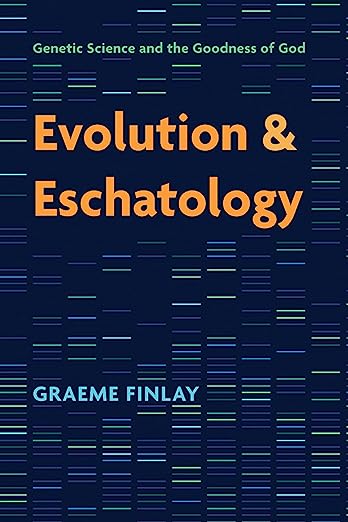
(Eugene, Oregon: Cascade Books, 2022)
Review by Stephen Pattemore
I need to say at the outset that Graeme is a very particular personal friend, with whom I have shared the journey of pursuing Science through the eyes of Faith for a very long time. So I write as a friend, but also as someone who has come to this discussion from the physical rather than the biological sciences. In fact all the genetics I know I have learned from Graeme!
Graeme is both a scientist (and a quite brilliant one at that ) and an eloquent Christian and has for decades been working to demonstrate that these two callings are entirely coherent, that the very public narrative of a clash of world-views – popularised in equal measures by atheistic science, popular narrative and conservative Christian argument– is a myth that needs careful and systematic deconstruction. This book is another step in that journey.
The book begins with a personal account of Graeme’s history, after which he provides the reader with “a crash course in genetics.” The essential given here is that the genetic code in the DNA of humans and a vast array of other creatures, has been decoded and studied in some detail, mostly during the course of the present century. This has allowed a close examination of the historical relationships of the spectrum of living things in our biosphere. So this “crash course” explicates, in a way that has become familiar to anyone who has read Graeme’s previous books, the types of random events which regularly cause changes in the genetic code. It is probably a bit optimistic to think that someone like me can use the crash course (and the “how to” guide in the first main chapter ) and become a reputable geneticist – or even follow some of Graeme’s arguments in subsequent chapters. I remain in awe of this whole field of science and of Graeme’s obvious grip on such a detailed domain of knowledge, of which he gives us some glimpses in the five main chapters of the book. Each chapter integrates biological science with theological reflection.
The first and fifth of these chapters form two bookends. Chapter One sketches the evidence for human evolution and our relatedness to other living beings. This leads to a consideration of how to read the book of Genesis. There are two themes here. First there is an analogous relationship between the way in which biological evolution functions and the ways in which Genesis developed from and relates to the other similar cosmogenic texts of the Ancient Near East. But there is also a need to read Genesis as affirming historical change and development, such as is evidenced in the biological evolution of humans from earlier creatures. Chapter Five develops this historical view of both biology and anthropology. One of the uniting themes through the book is the way in which the (comparatively short time-scale) evolution of cancer within the human body echoes the (much longer time-scale ) of the evolution of species with many of the same mechanisms driving both. This leads to questions of purpose and theodicy. Graeme argues that biological evolution, driven by chance, remains an incomplete and open process. It makes no claims to directionality or purpose. But it leaves those questions open rather than shut (as is popularly supposed) and this is where Christian theology has such an important part to play in our self-understanding.
The middle three chapters each deal, from a biological point of view, with the evolution of three very specific and complex systems of human functioning: the placenta, the brain and the immune system. Evidence for the random evolutionary events which have led to the constructive complexity of each of these is adduced. This might be sufficient and an abundant cause for wonder for the materialist scientist. But Graeme needs to bring this alongside of the understanding of a creating and loving God as revealed in the Scriptures, and this leads to many further questions and much enlightening discussion. After describing the evolution of the placenta, Graeme points out that human history, like biological history, is full of random and apparently directionless events. And yet the Christian belief is that the same God is in control of both. So biological history has an a analogous relationships to other histories – cosmic and human – with which we may be more familiar (and perhaps more comfortable). Light and understanding flow both ways. The same Creator God who makes “all things work together for good,” who regularly takes the weak and disregarded in order to shame the powerful and self-reliant, has used the random events of the evolution of the placenta to form a nurturing environment for God-imaged apes.
Chapter Three which traces brain development brings the two sides even closer together, because the identity of the self is at issue. Both science and theology are involved in a very similar quest – how does the sense of identity arise from a random collection of molecules? The answer on both fronts has to do with relationship. We are not ourselves without our connection to others. This is true both biologically and theologically. In this field the science and the theological anthropology are extremely closely tied together. Development in isolation leads not to normative but to pathological conditions.
Chapter Four, dealing with the evolution of the immune system, is perhaps particularly relevant in an era when immunologists and biological statisticians are public figures and popular heroes (or villains). Once again there is a communal dimension to our existence underlined here. The development of the immune system, says Graeme, “demonstrates the fallacy of genetic determinism, as antibodies develop only by engagement with an unspecifiable diversity of molecules originating beyond our bodies. The unity-in-diversity of immune cells provides a model of the collaborating members who constitute the body of Christ.” Here once again the relationship is that of analogy.
Whether or not the average materialistic biologist would be convinced by these arguments is an open question. I would hope they would be caused to think a great deal more carefully before dismissing the theological quest. And the thinking Christian must be caused to marvel at the works of a God who uses the happenstance of history to sculpt beauty and meaning. As a student of the biblical book of Revelation I began this book hoping perhaps for something more about “final matters” – but I found it not so much in a temporal scale, as a logical one. The Eschatology of the title has to do with meaning and purpose, and questions of ultimate – final – significance.
Graeme has once again done us all a great favour in sharing this amalgam of science and theology. The book is highly recommended to anyone with an interest in these fields – or the desire to develop their understanding in an integrated and integral way.
Review by Philip Pattemore:
Graeme is a scientist and Christian thinker whose passion in this book is to see that though science and theology address different questions, and use different tools, they are inextricably linked in understanding the created history of God’s world and humanity.
Graeme uses a genetic depiction of inserted genetic elements to show that human DNA contains many haphazard insertions of virus DNA and other mobile segments of DNA. Most of these are shared in near-identical form with other primates, in sections of DNA that are found in unaltered form in more distantly related animals, which means the insertions signify unique historical events occurring in the DNA of common ancestors of humans and primates. Humans are therefore linked to other creatures by a shared evolutionary past and ancestry. He goes on to discuss that a history of evolution by chance events is part of the freedom God has given the universe, and is highly compatible with over-arching purpose, a historically-contextual interpretation of Genesis, and sound Christian theology. Using the history in the genes showing evolution of the placenta, the brain, and the immune system, Graeme shows the influence of inserted gene elements that we share with primates, and the impact and limits of these changes for understanding humanity, created by God.
Understanding the freedom (or “contingency”) that evolutionary and human history is given by God, Graeme argues, including chance and chaos, is fundamental to understanding God’s purpose and future for his people and his universe, the eschatological vision.
This is a fine addition to the Christian literature on origins and purpose, and will yield rewards for those who delve into it.



